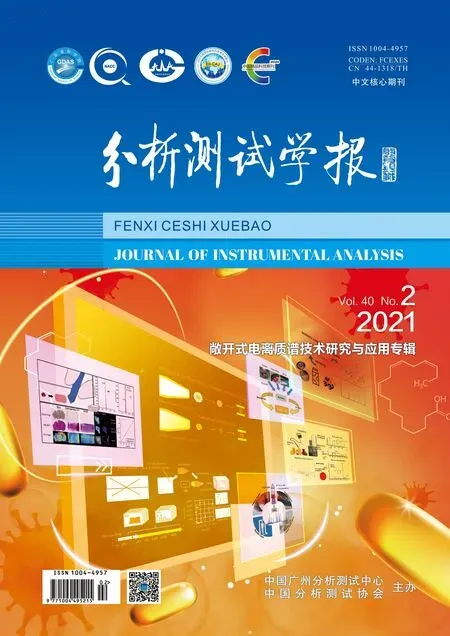Combination of Sample Pretreatment and Direct Analysis in Real-time Mass Spectrometry:Technologies and Applications
LIU Min,CAO Dan,LI Sheng-nan,BI Wen-tao*
(1.Jiangsu Collaborative Innovation Center of Biomedical Functional Materials,Jiangsu Key Laboratory of Biomedical Materials,College of Chemistry and Materials Science,Nanjing Normal University,Nanjing 210023,China;2.Guangdong Polytechnic of Science and Trade,Guangzhou 510430,China)
Abstract:In recent years,the rapid development of sample pretreatment techniques interfaced with direct analysis in real-time mass spectrometry(DART-MS) has allowed for the direct analysis on target analytes in complex biological,environmental,forensic and food environments,as well as individual small organisms and single-cell samples.However,difficulties in detecting the internal analytes in solid matrices and the poor detection performance of trace analytes have become key problems restricting the further development of DART-MS.To solve these problems,several attempts have been made in different research fields to combine sample pretreatment methods with MS.The combinations of sample pretreatment techniques,such as solid-phase extraction(SPE),dispersive solid-phase extraction(DSPE),stir-bar sorptive extraction(SBSE),solid-phase microextraction(SPME),mechanochemical extraction(MCE) and microwave-assisted extraction(MAE) with DART-MS are summarized in this review.The improvements that these combined methods may offer are detailed,and the future development trends are also proposed.It is hoped that this review will provide a reference or a basis for the future advancement of new sample treatment techniques in combination with DART-MS.
Key words:ambient ionization mass spectrometry;direct analysis in real-time mass spectrometry(DART-MS);sample pretreatment technique;review
The rapid detection of trace compounds in complex samples has become a challenge.In this regard,mass spectrometry(MS) is considered as a powerful analytical tool.Moreover,the progress of ionization technologies has played an important role in the development of MS.Electron-impact ionization enables the analysis of small organic molecules,while electrospray ionization allows for the analysis of large biological molecules.However,the main limitation of traditional MS ionization analysis is that it needs to be carried out under vacuum or in a closed environment.Furthermore,the sample requirements are relatively high,and extensive sample pretreatment steps are required before sample injection.Ambient ionization mass spectrometry(AIMS),which was firstly introduced in 2004[1],is a new family of technologies that has greatly simplified analytical processes and provided numerous application possibilities.AIMS is employed to analyze ionized and injected samples in an open laboratory environment,where the properties of the substances to be detected are maintained throughout the analysis.This technology can be used to analyze a variety of substances,from object surfaces to various substrates.
This transfer of ionization process from under vacuum to an atmospheric environment was undoubtedly a significant breakthrough in MS.Since the introduction of desorption electrospray ionization(DESI) in 2004[1]and direct analysis in real time(DART) in 2005[2],AIMS has become a promising tool in the field of mass analysis because of its high throughput,low matrix interference,high speed,and low limit of detection(LOD).DESI and DART are highly popular,commercially available,widespread atmospheric pressure desorption/ionization technologies.The similarity between these methods is that they “wipe off” analyte molecules from samples by exposing their surfaces to ionizing gases or aerosols.DESI is mainly applied for the analysis of polar compounds,while DART is suitable for analyzing nonpolar or semi-volatile low-molecular-weight compounds.When connected to MS,DART becomes a promising technology for many applications wherem/zvalues provide structural information[3].Its biggest advantage is that it does not come in contact with the sample.Thus,it can directly detect gaseous,liquid,and solid substances in their native state under atmospheric pressure.With minimal sample pretreatment,it can deliver the MS data in a minute,which is beneficial for the qualitative and quantitative detection of small-molecule compounds.Therefore,DART-MS is a well-known technology with many applications,including analyzing the ingredients of plant materials[4]and monitoring pesticides[5].It is also used in forensic and safety applications[6],such as screening for traces of explosives[7],warfare agents[8],or illicit drugs in luggage[9],clothes,or bank notes.However,the direct introduction of complex samples into MS may result in high matrix effects and low sensitivities of the target compounds[10].In addition,although DART-MS can effectively analyze the analytes on the sample surface,it cannot analyze those inside the sample.However,to combine DART-MS with a preconcentration/extraction step can facilitate the fast trace analysis of small molecules.Therefore,the development of a highly efficient sample pretreatment method is crucial for the application of DART-MS in sample analysis.To achieve target analyte extraction,matrix cleanup,and analyte enrichment,a variety of sample pretreatment technologies combined with DART-MS have been developed[11-12].In this review article,we further summarize the studies that have combined DART-MS with sample pretreatment technologies(see Table 1),including solid-phase extraction(SPE),dispersive solid-phase extraction(DSPE),dispersive magnetic solid-phase extraction(DMSPE),stir-bar sorptive extraction(SBSE),solid-phase microextraction(SPME),mechanochemical extraction(MCE),and microwave-assisted extraction(MAE).
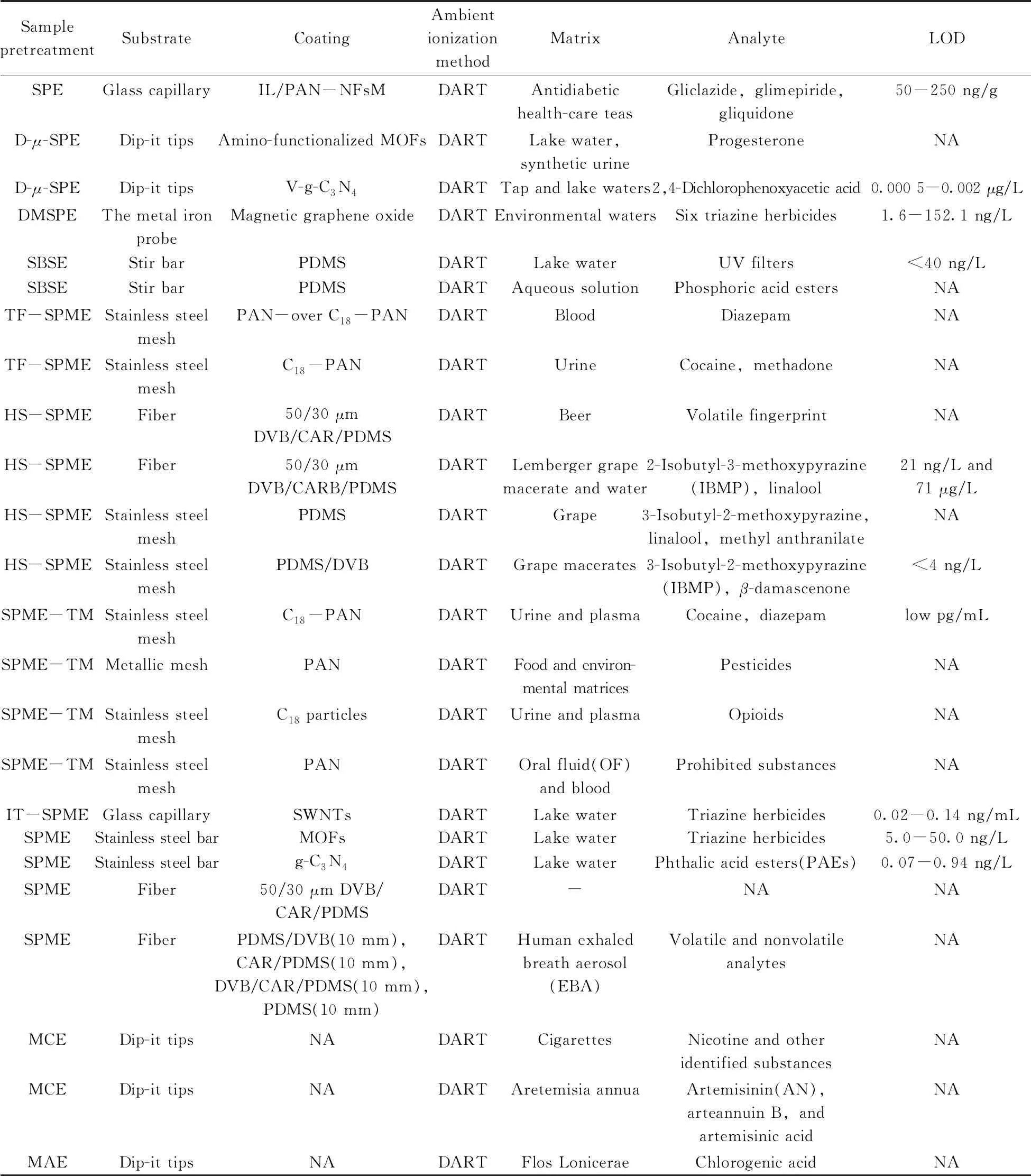
Table 1 Applications of direct analysis in DART-MS coupled with sample pretreatment technologies
1 SPE coupled with DART-MS
SPE is a widely used technology that was developed in the 1970s to separate or enrich analytes from water samples[13],and its solvent usage and exposure,disposal cost,and extraction time are all lower than those of the traditional liquid-liquid extraction method.Furthermore,it is easy to realize on-line SPE pretreatment and automatic analysis operation when it is combined with analytical instruments.
The coupling of SPE with DART-MS was reported by Cao et al.for the analysis of illegally adulterated sulfonylureas in antidiabetic healthcare teas[14].In their research,they utilized a novel ionic liquid(IL)-functionalized polyacrylonitrile nanofibers mat(IL/PAN-NFsM) to extract,purify,and concentrate analytes by SPE.This could eliminate the influence of endogenous interfering substances on the ionization of the targets.After performing SPE,the IL/PAN-NFsM-adsorbed targets were removed using forceps and then positioned to be analyzed by the DART source as a directly available sampling module without additional elution.Specifically,IL/PAN-NFsM was fixed to the bottom of commercial glass capillary tips for automated and direct analysis using a high-resolution mass spectrometer.Compared with other combinations of sample pretreatment methods and DART-MS,the combination of IL/PAN-NFsM-SPE and DART-MS effectively reduced the analysis time and improved the sensitivities(50-250 ng/g).Therefore,the proposed IL/PAN-NFsM-DART-MS is a fast and sensitive method for the high-throughput screening of analytes in complex matrices.Additionally,the SPE process of SPE-DART-MS exhibited better separation efficiency than those of the other pretreatments,which could ensure accuracy,sensitivity,and stability of the subsequent DART-MS detection.
2 DSPE coupled with DART-MS
Although SPE is applied broadly,it has some disadvantages,such as solvent loss,large secondary waste,time-consuming procedures,and complex equipment.Anastassiades et al.[15]firstly proposed the replacement of conventional SPE with DSPE in 2003.DSPE was considered to be a rapid,simple,inexpensive,and effective sample pretreatment method that works in the same way as SPE,but instead of loading the sample into the SPE column,a small amount of adsorbent is added directly to the solution and dispersed by eddy motion or stirring.Afterward,the phases can be easily separated by centrifugation.Compared with the conventional cleanup process of SPE,that of DSPE is greatly simplified and less time-consuming.Rapid screening of phenoxy carboxylic acids using DSPE coupled with DART-MS was implemented by Wang et al.in 2017[16],where enhanced analytical performance was observed.They outlined and discussed the applications of in-house-synthesized V-graphitic carbon nitride(g-C3N4) as the extraction material for DSPE.Afterward,the extracted analytes were eluted with a very low amount of organic solvent from the surface of the sorbent and were analyzed simultaneously using high-resolution DART-MS.The entire analytical process took about 10 min and numerous environmental samples could be measured.Throughout the process only 1 mL of methanol was required per sample,which is significantly lower than the amount used in the traditional methods.
Miniaturized DSPE(D-μ-SPE) with metal-organic frameworks(MOFs) coupled to DART-MS was also described by Li et al.in 2020[17].The choice of the adsorbent was proven to be the key factor influencing the whole sample pretreatment process.Amino-functionalized MIL-101(Cr)-NH2was facilely prepared through a one-step hydrothermal reaction and applied as a D-μ-SPE sorbent.They introduced elution into DART-MS by directly sampling the resulting solution via quartz tips(approximately 2 μL) and subsequently conducted DART-MS analysis.They improved the performance for the rapid and sensitive analysis of progesterone by SPE with amino-functionalized MOFs coupled to DART-MS.When combined with DART-MS,this technology achieved good sensitivity with LODs of 0.5-500 ng/mL for target analytes under optimum conditions,as well as a satisfactory correlation coefficient(R2=0.999 2).Using this method,the rapid determination of progesterone in different samples was realized.
Similarly,DMSPE,a modified form of SPE using magnetic material as the sorbent,has gained research interest for its possible use in sample pretreatment.Magnetic nanomaterials are suitable replacements for conventional SPE adsorbents,and they have large specific surface areas,adsorption capacities,and high selectivity due to their small particle size[18].The magnetic properties of the sorbent composites enable rapid phase separation by simply applying an external magnetic field,in which they can be easily isolated from the matrix.This eliminates the need for time-consuming centrifugation or filtration steps,providing relatively fast sample pretreatment.Jing et al.demonstrated the use of DMSPE with DART-MS for the first time and used for the successful high-throughput trace analysis of six triazine herbicides in environmental samples[19].Three magnetic graphene oxides(MGOs) with different ratios of Fe3O4-NH2and graphene oxide were utilized for the extraction(Fig.1).After the extraction,the 12-Dip-It module with magnetic iron probes was used to collect the magnetic particles,which were placed on the linear moving rail assembly of DART.Thereafter,5 μL of a 0.5% FA aqueous solution was added to the MGO on each probe before DART-MS analysis.Under the optimal conditions,the LODs for the triazines were determined to be in the range of 1.6-152.1 ng/L.The experimental results demonstrated that the use of DMSPE-DART-MS increased the detectability of triazines,thus improving the signal intensities and making this method more environmentally friendly.Therefore,studies have shown that DSPE can be effectively combined with DART-MS,and this method can be widely applied in environmental analysis.
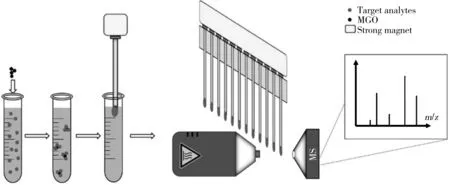
Fig.1 General scheme of DMSPE-DART-MS method
3 SBSE coupled with DART-MS
A solventless sample pretreatment method called SBSE was introduced in 1999,wherein an extraction-coated stir bar self-stirs to avoid the competitive adsorption caused by magneton agitation that is commonly seen in SPME[20].This method is suitable for enriching volatile and semi-volatile organic compounds in water and gas media and for analyzing environmental,food,pharmaceutical,and biomedical samples.SBSE coupled with DART-MS was firstly demonstrated by Haunschmidt et al.in 2010[21].This coupling promoted high-throughput extraction from environmental waters contaminated with ultraviolet(UV) filters,thereby improving the reliability of the DART-MS analysis.TwisterTM stir bars from a 2-cm-long Gerstel coated with a 0.5-mm layer of polydimethylsiloxane(PDMS) were cleaned,directly immersed into the water sample,and then manually inserted into the DART source using tweezers for the desorption and ionization for MS analysis.In this study,the extraction time was up to 1 h,which was better than those of most of the aforementioned methods.However,the linearity(R2>0.959) of this method was barely satisfactory,and semi-quantitative analysis was performed to obtain fast preliminary information about the approximate concentration of a certain analyte.Given that the position of the tweezer was not fully reproducible,therefore,the reproducibility and linearity of this DART-MS technology were not good.
A small amount of MGOs is added into the aqueous sample,which is then subjected to ultrasonication followed by vortexing or shaking.The MGO with adsorbed analytes was then separated from the solution using a metal iron probe with a magnet before DART-MS analysis[19].
A unique investigation was performed by Bridoux et al.[22]in 2015 to clean up and analyze phosphoric acid alkyl esters(tri-(TnBP),di-(HDBP),and mono-butyl phosphate(H2MBP)) from aqueous samples.They used a commercial stir bar coated with a 0.5-mm layer of PDMS(TwisterTM,1 cm length) as the extraction phase and immersed the sample in 2 mL of water while stirring for 60 min.Subsequently,the coupling of SBSE with DART/Orbitrap-MS was achieved by placing the TwisterTM stir bar in the middle of a custom-made,open-ended glass tube between the DART and the OrbitrapTM.This method showed reasonable linearities(R2≥0.980 9) in the concentration range of 0.1-750 ng/mL with the isotope dilution applied,and the relative standard deviation(RSD) of the reproducibility was less than 4% when the respective perdeuterated internal standard was used.The hyphenation of SBSE with the DART ionization source is a novel approach that could improve the reliability of DART analysis.
4 SPME coupled with DART-MS
In 1990,Arthur and Pawliszyn[23]proposed a new method,SPME,in which the stationary phase was coated on the fibers of a syringe needle,which would be dipped into the target solution.The analytes would adsorb onto the stationary phase and then be directly analyzed or eluted.This method has been widely reported as a convenient approach for analyzing targets in food and environmental matrices.Therefore,SPME could eliminate the need for solvents or complicated apparatuses for concentrating volatile or nonvolatile compounds in liquid samples or headspace(HS).SPME has found many applications in the analysis of various compounds when coupled with gas chromatography(GC)[24],high-performance liquid chromatography(HPLC)[25],and capillary electrophoresis(CE)[26].Thus,it could be coupled with DART-MS.
As demonstrated in the aforementioned research,it is not difficult to imagine the use of SPME-DART technology to screen for pesticide residues in food products,contaminants in environmental samples,or impurities in drinking water.In fact,Wang and coworkers coupled SPME to DART-MS for the screening of trace pollutants in water[27].The application of MOFs in sample pretreatment is also an emerging concept,as they exhibit great thermal stability at temperatures in the range of 300-600 ℃,a uniform porous structure,and a high surface area ranging from 200 m2/g to 7 000 m2/g,making them ideal sorbents for extraction[28].Wang and coworkers designed a laboratory-made SPME device coated with a MOF(MIL-100),where stainless-steel wires with different diameters were used to fabricate the SPME fiber that was treated with an aqua regia solution to obtain a rough surface.Subsequently,the end of the wire(2.0 cm in length) was dipped in silicone glue and then inserted into the MIL-100 powder.The stainless-steel wire coated with MIL-100 was washed and dried to produce the SPME fibers used in this work.The SPME fibers coated with MIL-100 were extracted from water samples spiked with triazines using optimal conditions and were then placed at the inlet of the DART-MS apparatus.The results showed that the LODs of the target compounds were in the range of 5.0-50.0 ng/L and the recoveries ranged from 92.4% to 125.7%.The application of an environmentally friendly device based on MOF-coated SPME coupled with DART-MS for the pretreatment and analysis of four triazines in water samples was demonstrated without requiring organic solvents.This technology shows great potential for the detection of a wide range of trace organic micropollutants in a variety of environmental samples.
Regarding SPME-MS coupling,g-C3N4-based materials were also recently introduced.It is known that the types of sorbents and solvents used in the sample pretreatment process have a significant influence on the analytical results.The adsorption,desorption,and ionization of the analytes are also considered to be possibly influenced by the morphology of the sorbent and the solvent type.Jing et al.developed a sorbent and solvent co-enhanced DART-MS(SSE-DART-MS) method for the high-throughput determination of trace pollutants in water,which gave more enhanced signals for the trace pollutants compared to those provided by DART-MS[29].
Newsome et al.combined the DART probe,SPME fiber,and inlet of a high-resolution mass spectrometer using an enclosed interface[30].The interface was mounted with a needle guide,an SPME fiber holder assembly,DART,a Vapur flange,and a shutter actuator.The fiber strand was modified to alternate with a standard GC heating inlet and a custom-designed interface that connected the DART probe cap to the MS inlet.This interface also keeps the other components of the analysis system in fixed locations.To control the SPME fiber positioning,an aluminum needle guide was fitted to the top of the SPME-DART-MS interface.For DART experiments,an SPME fiber holder is threaded into the mounted guide on the DART-MS interface.Subsequently,the plunger is depressed and locked into position,with the SPME fiber placed at the center of the post-plasma flow pathway.Newsome et al.optimized the inlet flow speed and desorption temperature to maximize the thermal desorption efficiency of derivatized acetic acid from an SPME fiber without destroying the fiber coating[30].This interface directly complements current commercial available technology.
Yuan et al.[31]were the first time to combine a face mask with SPME fiber to collect and analyze exhaled breath aerosol(EBA).The SPME fiber was inserted into the mask to form an SPME-in-mask setup covering the nose and mouth for in vivo sampling of EBA(Fig.2).Afterward,the molecular composition of the EBA was analyzed directly under ambient conditions.The conditioned SPME fiber was fixed in the face mask with a clip to keep it far away from the lips(~1.0 cm);thus,the lips were far away from the SPME coating and the top screw of the SPME fiber did not block the sight.The SPME-in-mask-DART-MS system has two remarkable characteristics:the extraction fibers are selective toward the target analytes,and the SPME sampling process is separated from the DART-MS detection process in time and space.Overall,this system is very effective due to its high sensitivity and specificity.However,the quantitative detection of target analytes in EBA is challenging.
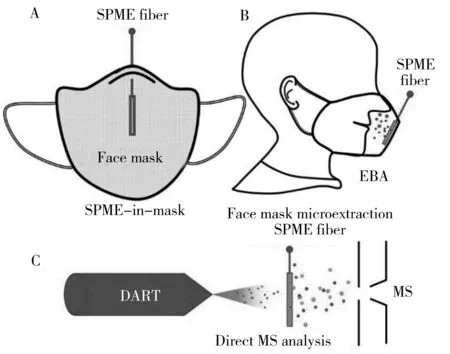
Fig.2 Schematic diagram of solid-phase microextraction(SPME)-in-mask sampling and direct MS analysis of EBAA:SPME fiber inserted into face mask(KN95);B:SPME-in-mask setup worn for collecting EBA;C:direct coupling of SPME with DART-MS[31]
Based on these previous studies,a technology is adopted where the fiber is coated with different materials to adsorb analytes.However,further improvement of this combination technology is necessary.To date,the field of SPME coupled with DART has been broadened and successfully applied to detect targets.
4.1 HS-SPME coupled with DART
By exposing the target analytes to the sample HS,they can be adsorbed on the fibers,in which case matrix interference is greatly reduced.This offers high throughput performance and does not require extended sample pretreatment,thus saving time.The potential combination of SPME and DART-MS is a useful strategy for obtaining the fingerprints(GC profiles) of beer volatiles,which was investigated by Cajka et al.[32].They tested five different SPME fibers,and finally,a 50/30 μm divinylbenzene-carboxen-polydimethylsiloxane(DVB/CARB/PDMS) fiber was employed for extraction with both HS and direct-immersion(DI) modes.Subsequently,the fiber was transferred between the DART source and the MS inlet and desorbed directly for time-of-flight MS(TOF-MS) analysis to obtain chemical fingerprints.The SPME-DART-TOF-MS system was tested in both HS- and DI-SPME modes.However,substantially different mass profiles were obtained.The experimental results revealed that the most obvious advantage of SPME-DART-MS was its application for the sorption/desorption/ionization of relatively polar compounds.However,the samples were not sufficiently volatile for HS-SPME sampling prior to GC-MS.Therefore,the combination of SPME-DART-TOF-MS enables new applications in food authentication,particularly the determination of relatively polar compounds,and provides an interesting option for SPME-GC-MS.
Similarly,Jastrzembski and coworkers proposed an application of coated meshes specifically designed for HS extraction and preconcentration of volatiles(solid-phase mesh enhanced sorption from HS(SPMESH)) prior to DART-MS[33].A 2 cm,50/30 μm DVB/CARB/PDMS fiber-coated stainless-steel mesh was suspended in the HS of an amber SPME vial containing 5 mL of solution and sealed with a stopper.Before that,the commercial OpenSpot cards were cut to facilitate the immersion of the stainless-steel mesh in the solution.Following extraction,the cut sample cards containing the coated mesh were flattened and stapled prior to DART-MS analysis.They achieved LODs of 21 ng/L and 71 μg/L for 2-isobutyl-3-methoxy pyrazine(IBMP) and linalool in water,respectively.The detection limits in the μg/L to ng/L range were achieved for volatiles,which is considerably lower than the limits reported for other chromatography-free approaches and is appropriate for measuring known,potent odorants.
However,the automation of the previous HS-SPME-DART-MS approach was a major challenge.Using these “one-shot” SPMESH devices,Bee et al.compared SPMESH-DART-MS and SPME-GC-MS for measuring three representative odorants(3-isobutyl-2-methoxypyrazine,linalool,and methyl anthranilate)[34].PDMS sheets were cut to fit 24-well plates prior to laser etching.A prototype was made into square cutouts to obtain a suitable mesh lattice size.Thereafter,the SPMESH piece was placed on a porous plate containing the sample and incubated.Volatiles were absorbed onto the area of the SPMESH sheet directly above the well.Finally,the SPMESH and spacer were moved to the X-Z positioning stage for automatic DART-MS evaluation.Following optimization,the SPMESH-DART-MS approach could analyze odorants in 24 samples in 17 min with μg/L-ng/L-scale LODs,excellent accuracy,and good repeatability over two weeks.
However,there are several drawbacks to this approach,mainly due to the difficulty associated with automation in a one-time format.In a more recent work published by Madeleine and Bee,a workflow based on SPMESH sheet extraction followed by DART-MS was proposed for the evaluation of HS volatiles[35].They produced SPMESH devices by laser-etching a fine mesh pattern(0.5 mm×0.5 mm) into thin PDMS sheets(SPMESH sheets),realizing parallel HS extraction and preconcentration of volatiles from multiple samples.After SPMESH sheet extraction,the volatiles were desorbed and analyzed by DART-MS.Under optimal conditions,a good correlation was achieved between the SPMESH sheet-DART-MS and SPME-GC-MS for IBMP(range by GC-MS≤2-28 ng/L,R2=0.70) and linalool(range by GC-MS≤135-415 μg/L,R2=0.66).The SPMESH sheet approach improves the throughput and automation.The coupling method has attracted interest in the field of volatiles and exhibits remarkable advantages for these samples,improving the reproducibility of this SPMESH sheet approach and lowering the methodological detection limits.
4.2 TF-SPME coupled with DART-MS
An important development in sample pretreatment is the combination of membranes and SPME.The original form of the SPME fiber needs to be fixed manually in the module of the DART source to avoid severe fiber swinging and consequent irreproducible desorption-ionization of the extracted analytes.Therefore,thin-film microextraction(TFME) was developed to cater to this coupling system[36].TFME,which uses a membrane rather than a fiber to carry the extraction phase,is also a variant of SPME,providing a large surface area and allowing the use of a greater amount of extraction phase without increasing the time required to reach equilibrium.TF-SPME is readily coupled with AIMS,which allows for direct sample introduction into an MS instrument without a chromatographic step.TF-SPME coupled with DART-MS was firstly demonstrated by Mirnaghi and Pawliszyn in 2012[37].First,they successfully prepared UV-dried thin PAN-over C18-PAN for extraction,which provided the best biocompatibility and reusability for at least 30 extractions from whole blood.They also evaluated the performance of all PAN-over coatings under different drying conditions.The PAN attached to the C18-PAN coating offered a protective layer on the outer surface of the coating,thus improving the reusability and reproducibility.Apart from the wash step,the optimized SPME parameters for the PAN-over C18-PAN coating were the same as those for the original C18-PAN coating for the extraction of diazepam.For the DART application,to prevent blockage of the mesh holes by the coating and to guarantee the transmission of the heated gas through the coating for efficient desorption and ionization of the analytes,the coated mesh should be very thin.This is because the blood-spot volume can be increased by increasing the surface area of the coating.In this work,a 5 μL sampling volume was used for an entire extracted blood spot(EBS) study.Blood samples were deposited onto the meshes for extraction,after which the coated meshes were rinsed with pure water.Afterward,the SPME-coated mesh was completely dried before being introduced to the DART source.In this study,matrix-matched isotope dilution calibration was used for quantitation analysis with an LOD and an limit of quantitation(LOQ) of 0.3 μg/mL and 1 μg/mL,respectively.
The EBS methodology coupled with DART-MS/MS was applied by the Pawliszyn's research group for the analysis of doping drugs in urine,while TFME-DART-MS was employed by Rodriguez-Lafuente et al.to analyze cocaine and methadone[38].They prepared C18-PAN-coated meshes for the extraction and determination of the two doping substances.Using a small needle,a series of 12 tiny holes were made on the spotting area of the coated mesh to facilitate helium flow and ionize the target analytes.The results showed that thin-film SPME improved the detectability of these compounds:signal-to-blank ratios of 5(cocaine) and 13(methadone) were obtained in the analysis of 0.5 ng/mL of human urine.The application of high-throughput SPME in human urine facilitated the preconcentration of the analytes,thus providing efficient sample cleanup and preventing the contamination of the ion source by salt residues from the urine samples.These reports of TF-SPME-DART-MS focused on its application for non-volatiles,likely because the adsorbent particles employed are less appropriate for volatile extraction.However,directly interfacing SPME devices(e.g.,thin-film membranes,needle traps,or fibers) shows quantitation limits in aqueous and air samples for field instrumentation.
4.3 SPME-TM coupled with DART-MS
Gomez-Rios and coworkers used a new SPME device for the quick,solventless extraction/preconcentration of small molecules from complex matrices[39].A coated mesh preconditioned with a biocompatible polymer(C18-PAN) was immersed in a vial containing the sample matrix to enrich diazepam and cocaine by agitating the sample at a high speed.Afterward,the coated mesh was rinsed in a vial containing water to remove any potential artifacts stuck to the coating surface.The coated mesh was set up on a mesh-holder for the facile and rapid replacement of up to 12 SPME-transmission mode(TM) devices,and was mounted on an automatic linear rail that moved the mesh to the front of the DART source.This novel SPME device that is easily coupled to DART can be used for analysis,enrichment,and sample cleaning with operations completed in less than 1 min.Furthermore,the total analysis time does not exceed 3 min.This results in low,pg/mL-scale LODs and reproducibility below 5% RSD.
Another SPME-TM was coupled with DART-MS by Gomez-Rios et al.[40].SPME-TM acts as an effective integration between sample pretreatment and ambient ionization.The device consists of a metallic mesh coated with adsorbent particles glued together by PAN(a slurry of 5 μm hydrophilic-lipophilic balance(HLB) particles with PAN as the binder) at a thickness of <20 μm and a length of 1 cm for the DI extraction of pesticides in food and environmental matrices.This was followed by removing,rinsing,and directly analyzing the mesh by DART-MS.To establish a fast and simple method for multiresidue analysis in a complex matrix,no sample pretreatment was performed.Therefore,four matrices with completely different nutritional and physical characteristics were carefully chosen,which allowed for the simultaneous isolation and concentration of analytes from a given matrix.In addition,the SPME-TM-DART-MS system is faster and more sensitive than the automatic SPME-GC/LC system.This is because the analytes can be introduced into the MS system without further dilution.An LOQ in the sub-nanogram per milliliter range can be attained,and the total analysis time does not exceed 2 min per sample.SPME-TM has noteworthy advantages over other methods currently in use,including complete solvent elimination,minimal use of adsorbents,and significant time and labor savings.
Gomez-Rios et al.optimized the SPME-TM system to allow efficient preconcentration and quantification of analytes at low ppb levels[41].Since then,SPME-TM has been employed to detect pesticides in water,consumer beverages,and milk.With the improvement of this technology,Vasiljevic and Pawliszyn demonstrated the quantification of urine and plasma samples using an AIMS technology:DART coupled with SPME-TM.Instead of using hand-cut,stainless-steel meshes,they used a photoetched stainless-steel mesh with clear geometry to eliminate errors caused by human manipulation[41].The wet etching consisted of four stages of mesh sonication in various fluids:MeOH(2×20 min),HCl(1×20 min with brief shaking every 5 min),MeOH again(1×10 min),and finally deionized H2O(2×10 min).After completing these steps,the mesh was dried and kept in a dryer under a N2atmosphere until use.The coating process was carried out using 2 mL 96-well plates,in which 1 mL of coating slurry was deposited into 12 wells.During the extraction,the brush was completely immersed in a 96-well plate and stirred by shaking the track.After extraction and quick rinsing,the device was installed on a 12-position holder and accurately positioned between the DART source and the MS inlet for desorption and ionization.Low LOQs were obtained(0.5-25 ng/mL) for the matrices used.Acceptable accuracy(71.4%-129.4%) and repeatability(1.1%-24%) were obtained for the validation levels tested(0.5,30,90 ng/mL).At the same time,Vasiljevic and Pawliszyn combined the high detection sensitivity of DART with the preconcentration capability of SPME to realize SPME-TM HLB extractive particles that were used to quantify small volumes of abused drugs in human blood samples[42].Low,ng/mL-scale LOQs and very short extraction times(t≤1 min) were achieved using this SPME-MS configuration for plasma and urine analysis.
4.4 IT-SPME coupled with DART-MS
In-tube(IT)-SPME has been proven to be a reliable alternative for the on-line enrichment of many organic pollutants from aqueous matrices.This is because it allows the required amount of analyte to accumulate by introducing a large number of samples into the extraction unit,resulting in an instrumental response.On-line IT-SPME-DART-MS was firstly disclosed by Liu's group for the determination of six triazine herbicides in lake water and orange juice[43].The polymer monolith synthesized by single-wall carbon nanotubes(SWNTs) was supplied into a fused-silica capillary to form a monolith capillary for IT-SPME.The extraction device was formed by installing the monolith capillary into the pinhead of a syringe,which was connected to a syringe infusion pump to deliver the solution.The entire process included activation,sampling,washing,on-line desorption,and detection(Fig.3).A syringe pump was used to deliver the solution at a flow rate of 3.6 mL/h for activation,sampling,and washing.Finally,on-line desorption was performed at a flow rate of 1.5 mL/h,and DART-MS was operated simultaneously.With the IT-SPME-DART-MS method,the concentration LODs for samples in the range of 0.02-0.14 ng/L and six triazine herbicides were determined simultaneously,and satisfactory linearity(R2>0.998) was achieved.However,the operation of the system is cumbersome and requires additional instrumentation.
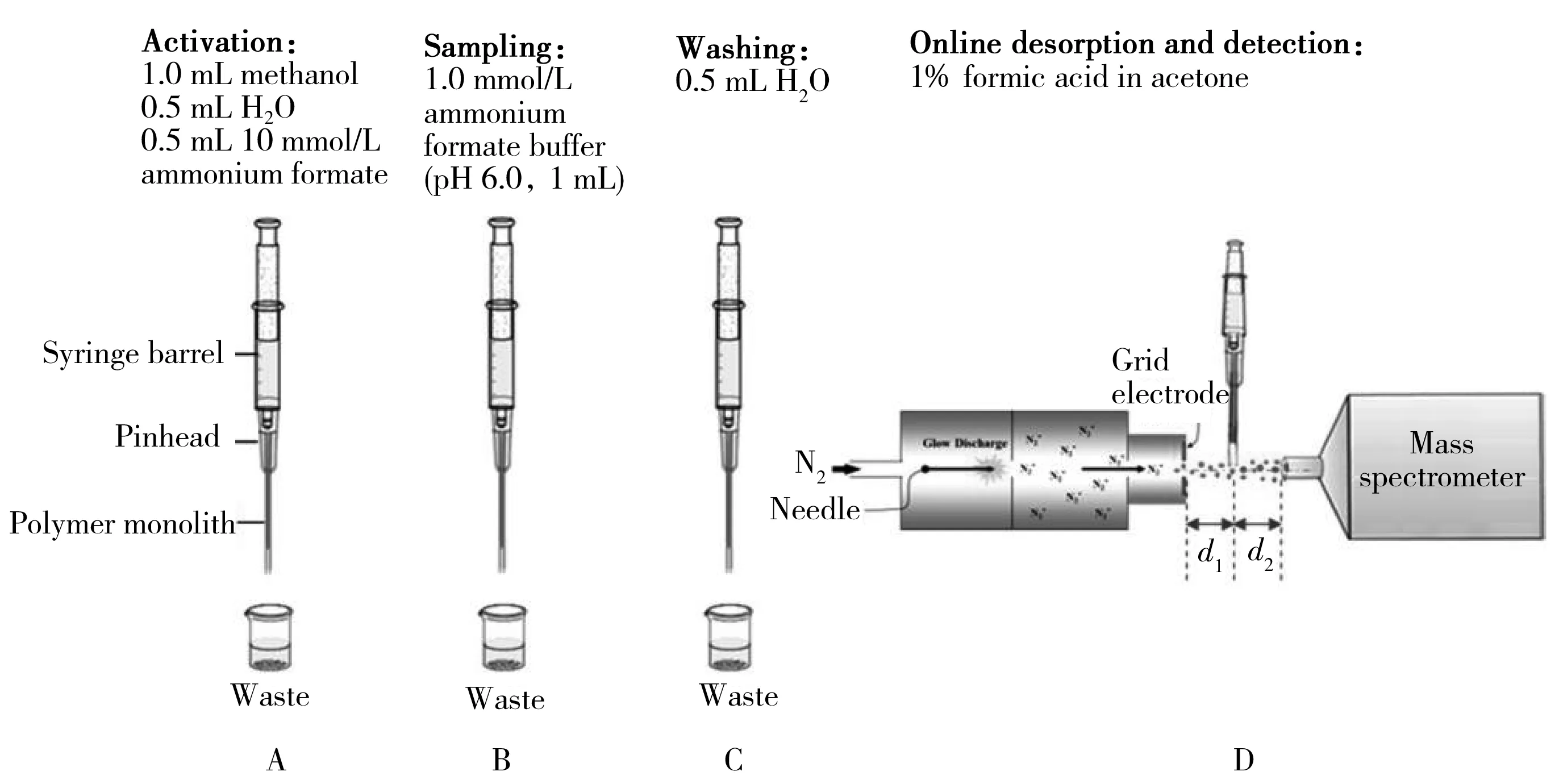
Fig.3 Experimental protocol and configuration of the on-line IT-SPME-DART-MS systemthe entire experimental procedure involved four parts:A:activation,B:sampling,C:washing,D:online desorption and detection(top view,where d1=d2=3 mm)[43]
5 MCE coupled with DART-MS
Solid samples require exhaustive extraction to release analytes that are often closely bound to the sample matrix.For volatile analytes,a combination of HS extraction-SPME or SBSE is an immediate option.For other analytes,MCE and MAE are promising methods[44-45].MCE employs a mechanical treatment device that is effective for shaping a variety of materials,including metals,alloys,polymers,and low-molecular-weight organics.It is often used to destroy cell membranes under wet or dry conditions.The unique motion of the ceramic ball is utilized to crush the raw material and completely break the cell wall and lipid layer.It can release the extracted material almost completely into the surrounding solvent in less than 1 min.MCE improves the extraction rate and shortens the process time than those of conventional methods.
Jiang et al.reported a methodology that combined an efficient sample pretreatment method(MCE) and high-throughput sample analysis(DART-MS) technology to afford a simple,rapid,and complete analytical method for the simultaneous determination of multiple components in cigarettes,where the process time was on the scale of minutes and mass errors were less than 10 ppm[46].Principal component analysis showed that there were significant differences between the extraction of different types of cigarettes with the same solvent and that of the same type of cigarettes.However,solvents,particularly organic solvents,are widely used in a variety of sample pretreatment procedures,including MCE.Traditional organic solvents can be toxic,leading to pollution and disposal concerns.
Wang firstly developed a method that used deep eutectic solvents(DESs) for MCE combined with DART-MS[47].For more extensive applications,a new generation of green solvents(DESs) has emerged[48].DESs are composed of a hydrogen-bond acceptor and a hydrogen-bond donor for increased intermolecular forces through hydrogen bonding and van der Waals interactions.DESs have attracted increasing attention because of their simple pretreatment process,non-toxicity,good biocompatibility,and low cost.They are widely used in catalytic process design and the syntheses of polymer materials and small molecules.Given these benefits,MCE combined with DESs may provide a promising alternative process for the extraction of active components from raw materials(Fig.4).MCE is performed at room temperature,and the target analyte is released into the DES in seconds.DART-MS has been used to identify and quantify the three main components of artemisinin extracted from plants collected from five locations.All the operation steps are simple and the whole procedure takes only a few minutes to complete.The introduction of DART-MS and this DES-based MCE methodology provides a promising alternative for the extraction and determination of thermally sensitive and bioactive compounds.
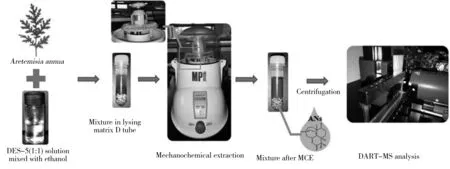
Fig.4 Overall scheme for the highly efficient,deep eutectic solvent(DES)-based mechanochemical extraction followed by quantitative analysis with DART-MS[47]
6 MAE coupled with DART-MS
MAE involves the use of microwave energy to enhance the solvent-extraction efficiency,that is,the use of microwave heating to accelerate the solvent-extraction process of the target analytes(mainly organic compounds) in solid samples.This extraction method has been applied in the gas,oil,food,medicine,and perfume industries.MAE has the advantages of short extraction time,high extraction rate,and good product quality.In addition,it is more environmentally friendly.An approach in which MAE was used to extract chlorogenic acid from Lonicera japonica,followed by quantification using DART-MS/MS,was proposed by Yao and coworkers[49].The DART-detection factors,including the gas temperature,grid electrode voltage,and sample presentation speed,were investigated to obtain the optimal signal intensity.The entire procedure of MAE combined with DART-MS only takes minutes to obtain semi-quantitative results from Lonicera japonica.
7 Conclusions and prospects
As summarized in this review article,the combination of sample pretreatment technologies and DART-MS facilitates excellent sample cleanup of complex matrices,improved sensitivity,accuracy,and precision,significant enhancements in analytical throughput,and improved qualitative and quantitative analysis.Although various successful combinations have been presented,further efforts are still required.Since sample pretreatment is the bottleneck of analytical procedures,the trend of sample pretreatment will move toward automated systems that can be integrated with final separation and new coupling methods,which are highly encouraged.Portable and solvent-free sample pretreatment technologies are highly desirable,and SPME is an example of a pretreatment that could be used in such applications.Attention should also be paid to the development of new fiber coatings for different target compounds that can then be combined with DART-MS.In addition,the quantitative capabilities of these combined systems remain challenging and require further improvement.The key factors inhibiting the combined effect of sample pretreatment technology and DART-MS need to be further explored and studied to improve the analytical performance of these methods.Such developments and improvements are expected to occur in the foreseeable future.

